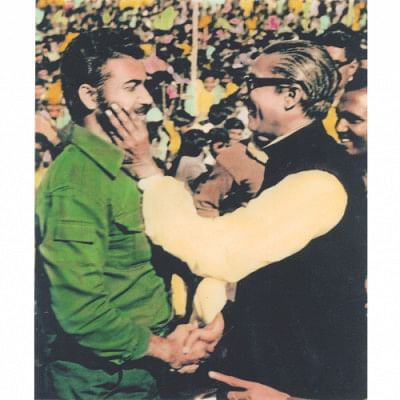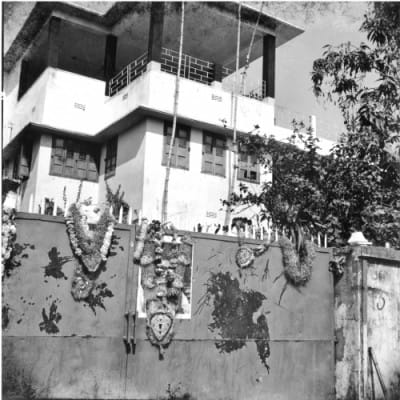One of Kamrul Alam Khan Khasru’s valiant missions

The month of December ushers in the spirit of patriotism in every Bangali as the essence of victory fills the atmosphere. Why wouldn’t it? Our beloved nation is the labour of extraordinary struggle, bloodshed, mutiny and beyond. As captivating as the history of our victory may sound to us today, especially to the generation born in an independent Bangladesh, it was much different for those who led us to this victorious moment. Many who fought the Liberation War of 1971 have perished while those who survived have not been able to get over the horrors of those bloody nine months. It is their accounts that we base much of our history upon. Apart from the major incidents during the war that many of us are familiar with, there are many more narratives of individual experiences and encounters that serve as slices of history adding to the glory of our victory. The following is one such chronicle about a Freedom Fighter named Kamrul Alam Khan Khasru during the dark days of war. Known for his stark bravado amongst the community of Freedom Fighters and the general public, Khasru was on the list of the “most wanted” by the Pakistani military during 1971. Following independence, Khasru also starred as a Freedom Fighter in the first Bangladeshi film on the Liberation War directed by Chashi Nazrul Islam titled, “Ora Egaro Jon”.
The incident Khasru narrates took place on the outskirts of Dhaka in Ruposhi, on the banks of the Shitalakshya River which was a strategic location during the war due to its proximity to the industrial area with one side facing the Demra ghat and the other Tarabo ghat. It was one of the few locations that the Pakistani army did not wipe out. They had deliberately set up heavily armed bunkers on either side of the road near the bank, one which led towards the Narsingdi-Sylhet highway and the other towards Cumilla-Chattogram highway.
Initially, 11 Freedom Fighters including Khasru, who was the group commander, acquired guerilla warfare training from India in Dehradun. They later set up camp near the Shitalakshya. Blending in with the local community, they kept a close watch on the enemy, ready to attack when the opportunity was right. During that time Khasru would also travel to Dhaka to carry out missions, making use of different paths each time. In the first week of December in 1971, Khasru and his comrades assisted the Mitro Bahini (Bangladeshi and Indian allied forces) to cross the river while they were en route to Dhaka. Overtime, the Freedom Fighters established other camps across the area and further made use of an under-construction factory owned by Jahurul Islam to store their arms and ammunition.
During monsoon, much of the region would be submerged due to floods, a situation Khasru and his comrades used to their advantage while surveilling the area against the Pak army who were not at all good swimmers. Upon learning about a local aristocrat in the area named Motalib Khan, a former navy officer who supported the Liberation War, Khasru decided to meet with him to secure whatever assistance they could get from him. Armed with his much-admired light machine gun (LMG), five loaded magazines and H E 36 hand grenades, on September 7, 1971 Khasru embarked on his boat (choi nouka) from Shalipur camp along with a steersman named Sunil, a teenager who was an expert at navigating the waters. While departing, Khasru informed his comrades that if they suddenly heard continuous firing, they should assume it was him and take action accordingly.
In order to reach the destination, the duo had to cross from underneath a bridge near the Narsingdi road. As Sunil steered the boat which was veiled with a saree—an indication that religious women are on board—Khasru remained hidden. Suddenly, Sunil steadily alerted that a jeep was speeding towards Tarabo ghat and as Khasru peeked through the screen to scan the situation, he immediately figured that they had been targeted as five to six armed men on the jeep had their artillery pointed towards them. Khasru realised that if the boat was turned around, they would surely come under fire and if they continued, they would definitely be stopped as it neared the bridge. With death around the corner, Khasru used the veil to his advantage as he swiftly maneuvered himself into the water under its guise while the young boy propelled against the current keeping his calm all the while. Stealthily, Khasru swam to take shelter right under the very bridge which the jeep was speeding towards and just as the boat neared, he heard the men ordering Sunil to stop the boat and remove the saree so that they could inspect it from above. Seeing that the boat was empty, the soldiers got back on their vehicle and left the scene. With a sigh of relief, Khasru swam back on the boat and the two commenced their journey.

After reaching Motalib Khan’s residence, not only did they receive a warm welcome, but Khan also ensured that the Freedom Fighters could use his residence when required and further expressed his willingness to participate in the war. All of a sudden there was a commotion outside the house and people were running frantically. Upon inquiring, Khasru learned that the Pak military was looting the local bazaar—they would often do so to flex their authority upon the locals while extorting their commodities—and gathering individuals in queues. No one could give an exact headcount of the soldiers, but Khasru was informed that they came on three patrol boats. Infuriated, Khasru requested Khan for a brave helper while he began to plot an attack in his mind. Khan suggested that Ajay would be the right person to accompany him on the boat ride back. As they reached the outskirts of Ruposhi bazaar, Khasru examined the surroundings and noticed three patrol boats at the bank and began to weigh his options as to whether he should conduct a raid or an ambush. But as time was of the essence, the situation seemed suitable for an ambush. Khasru asked Ajay to manage a shovel with which he dug a mini trench by the river bank and took position with his LMG under the camouflage of the bushes.
Pleased with their pillage, the Pak military carelessly began to head back to their camp on the patrol boats unaware that Khasru was patiently waiting, finger on his trigger, scoping for the moment to unleash his wrath upon them. As soon as they were within his range, keeping the Shitalakshya River as a witness, Khasru vowed to mark the day as a memorable chapter in history, determined to annihilate his enemies singlehandedly he pulled the trigger with all his rage riddling his targets with bullets as he exclaimed “Joy Bangla” emptying all five of his LMG’s magazines. Two of the patrol boats sank shortly while the third one drifted away with wailing voices from the remaining wounded soldiers on board. Unbeknownst, they too opened fire haphazardly at no proper target. With luck in his favour, Khasru managed to dodge their bullets by a few centimetres and remained unharmed throughout the ambush as his guerilla training proved worthwhile. He was later informed that the third boat reached Demra ghat but had more dead bodies than alive.
Following the incident, the Pak army brought in reinforcements, shut down the ghats and attacked with mortars and heavy machine guns, killing whoever they found ruthlessly and set houses ablaze, including that of Khan’s who managed to escape with his family. Prior to that, Khasru had informed the villagers of the possibility of a counterattack by the enemy and asked them to abscond, and at the same time transferred his base along with his comrades. Those who didn’t pay heed weren’t as lucky. Meanwhile, the Freedom Fighters were just three kilometres away at a nearby village, ready to engage in combat. However, despite them being heavily armed, without any functional boats to travel with, the Pakistanis did not dare attack the village where Khasru and his comrades set up camp. Or perhaps they somehow sensed that a destructive fate awaited them all on the other side.
Having accomplished many fearless missions with ingenuity throughout 1971, Kamrul Alam Khan Khasru considers Operation Ruposhi as one of the most thrilling and remarkable undertakings of his life. And he was able to carry it out due to his loyalty for the land, its people, and the Father of the Nation Bangabandhu Sheikh Mujibur Rahman.
Minam Haque is a member of the Editorial Team.

 For all latest news, follow The Daily Star's Google News channel.
For all latest news, follow The Daily Star's Google News channel. 



Comments